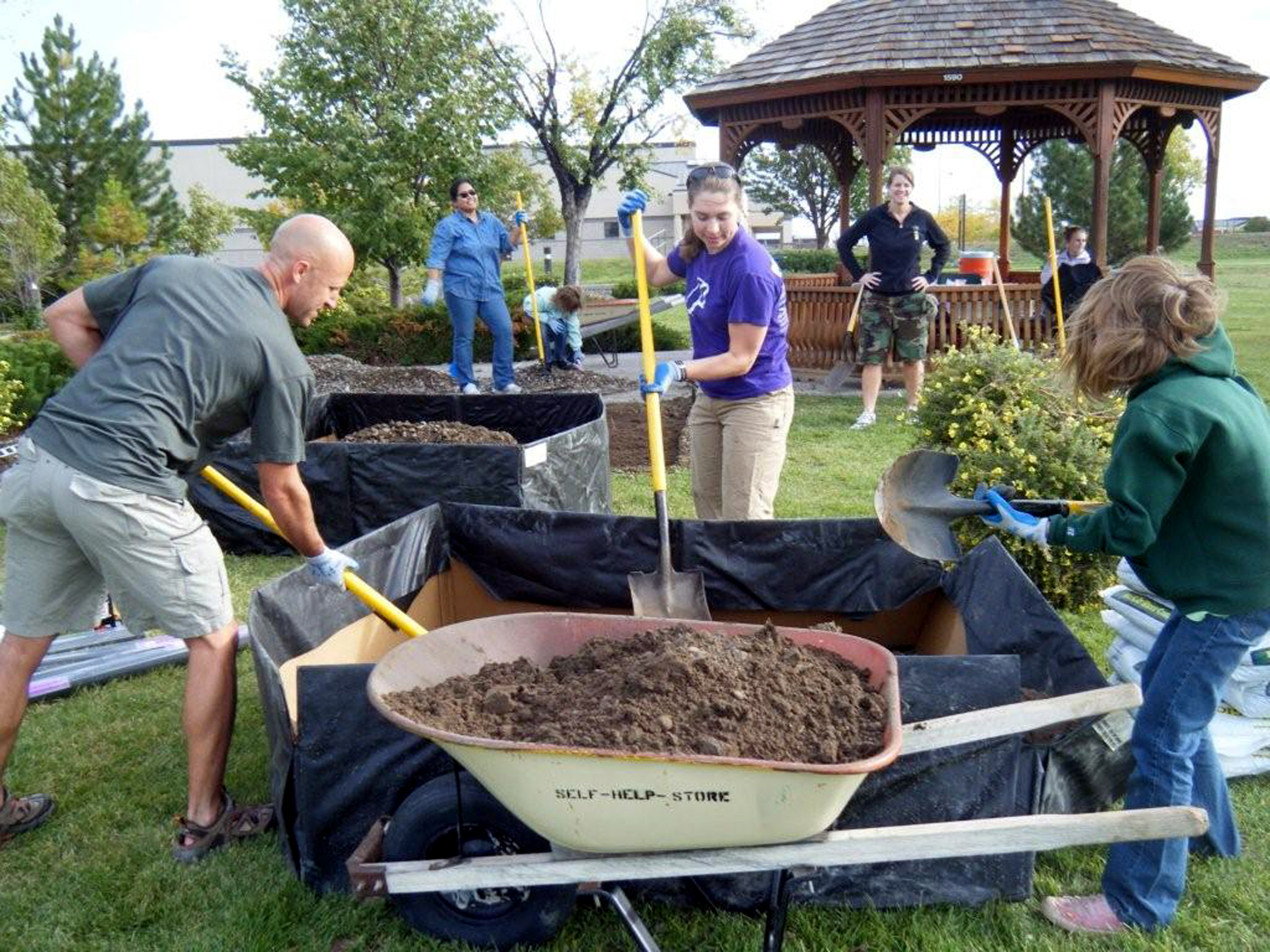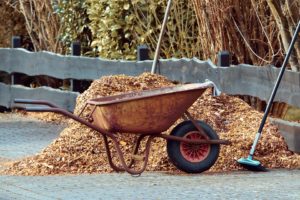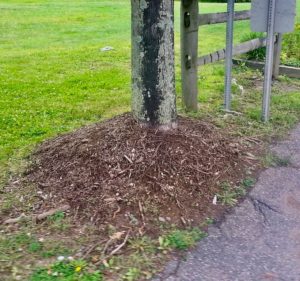
Mulch Madness!
Mulching seems to be the popular outdoor sport.
For the past month or so and despite our chilly, rainy spring here in the Northeast, everyone is mulching like crazy! Mulching seems to be the popular outdoor sport. Landscaping trucks piled with yards and yards of mulch can be seen racing down country lanes and city streets alike. Every garden bed, large or small is being mulched. Along sidewalks, under trees and shrubs, in parking lot islands and city street median plantings, every inch of non-lawn area is being covered in mulch.

All this mulching – is it good or . . . crazy? When is mulch helpful and when does it cause problems? And what’s up with red mulch? Let’s look at the facts about mulching as well as why we mulch to gain a better understanding how to mulch.
Next time you walk through a forest, take a look at the forest floor. Push back some of the dry leaves to uncover the next layer – decaying leaves and plant matter. This is nature’s way of producing mulch. If you never cleaned your garden, mowed your lawn or raked leaves in the fall, nature would produce mulch for you as well. However, we do not want our gardens and lawns to look this type of “natural.” Plus, we’ve likely invested time and money in developing beautiful garden beds and a nice lawn. While it’s true we remove all of that great stuff when we clean our yards and gardens, there is a balance to strike. Aesthetics are important. And that’s why we bring in commercially produced mulch.
Benefits of Mulch
With the proper choice of mulch products and with correct application, mulch will bring many benefits to your garden landscape.
1. Weed suppression – The application of a 2-3 inch layer of mulch can be effective in suppressing weed growth. Remove weeds before laying down mulch. As you rake out the new mulch in your garden bed, carefully pull away mulch from the bases of plants and shrubs. You will still need to weed from time to time during the growing season, but you will notice that weed growth will be far less.
2. Water retention – Mulch reduces the amount of water evaporating from the soil. This reduces stress on plants during hot summer weather. Here at The Dirt on Dirt, we recommend the use of Hydretain® in conjunction with mulch. Hydretain contains humectants which help keep moisture in your soil. Water your garden beds first with Hydretain, apply a 2-3 inch layer of mulch and you should observe happy, healthy plants needing watering less frequently.
3. Soil temperature regulation – Many plants and shrubs can suffer stress during high summer temperatures. A mulch layer will also keep your garden soil cooler. See for yourself – push back an area of mulch and dig slightly into the soil beneath. You will be surprised at how cool the soil feels compared to the air temperature.
4. Nutrients for your plants – while not a substitute for fertilizers, as organic compost breaks down and the decaying matter improves your garden soil. The improved soil particles are lighter and less compact, which is great for root growth and movement of nutrients through the soil. The finer the mulch particles, the quicker the mulch will break down. Earthworms love decaying organic matter, and earthworms will help improve your soil too!

Mulching Problems
If a little is good, is a lot better? When it comes to the proper application of mulch in the garden landscape, the answer to this question is a resounding “no.” A thick layer of mulch (over 4-5 inches) might actually reduce the amount of water getting to plants. Mulch can become water repellant (hydrophobic) with water actually rolling off the layer of mulch, leaving plants to dehydrate and wilt.

A big problem we see in the tree industry is “volcano mulching” – a thick layer of mulch in a circular bed around the tree, mounding up around the tree stem. This will eventually kill the tree. Trees have a dense layer of fine roots, spreading out around the tree near the soil surface. This is where the tree picks up much of its vital nutrients and water. A thick layer of mulch will suffocate the tree. If you choose to mulch around your trees, use only a light layer – 1-2 inches is more than adequate. Be certain to pull away any mulch from the base of the tree. You should be able to see the trunk flare – area of the trunk above ground which curves out towards the roots.
Choosing mulch
Bark mulch – this is the most common type of mulch. Bark mulch is found usually in two forms – shredded bark (fine texture) or bark nuggets (larger and chunkier). Bark nuggets break down much more slowly. Shredded bark breaks down more rapidly and looks nicer in a garden bed. You may use bark nuggets in beds where you won’t be digging or planting. It’s a good idea to edge your garden beds before laying down mulch. A nice, clean edge keeps mulch from straying out onto lawn areas and walkways. Bark mulch can be purchased in bags from your garden center, or by the truck load from mulch companies. And red mulch . . . in general, the dye added to mulch will not hurt your plants. The dye does fade by the end of the season, giving the mulch a grayish look.
Wood chips – While not as aesthetically pleasing, wood chips make great mulch. You will see wood chips used in parks and play areas. Like pine bark nuggets, wood chips break down slowly. I like to use wood chips at the end of the season to mulch in plants and shrubs I want to protect over the winter.
Other types of mulch – Many other plant-based materials are commonly used as mulch such as compost, straw, pine needles, leaf mold (composted leaves), grass clippings and sawdust. Some of these are great to use in your vegetable garden to keep down weeds between the rows. Compost makes great mulch. Already decomposed organic material will improve your soil, feed essential microorganisms, and will help make nutrients available to plants. Your own compost bin will provide you with free mulch! Your local municipality may offer free mulch to residents at certain times of the year.

Mulch calculator
It’s good to know how much mulch you need before you buy. There are many good mulch calculators online. Your garden center will also help you with your calculation. First, measure the area(s) of your garden bed(s). If you are buying bagged mulch, one bag is generally 2 cubic feet. This will cover an area of roughly 9-10 square feet, with a 2-3 inch cover.
Plan ahead
It’s a good idea to make a plan for mulching your gardens and other areas of your property. Decide what type of mulch you need and if any areas could use compost instead of mulch. Consider using our moisture management product, Hydretain, to help reduce your watering time. Take accurate measurements, purchase the right amount of mulch and . . . happy mulching!
Sincerely,
Francesca


Sorry, the comment form is closed at this time.